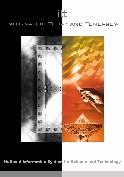
Vol 21 No 1 March 2002
It is all so simple. Get a new signboard painted and a new letterhead printed. After all, what is in a name? A Department of Library Science could overnight become a Department of Library & Information Science _ infrastructure, teaching staff and curricula remaining the same. The Indian degree awarding machines have been churning out students in hordes _ most of them ill-equipped to cope up with today's new paradigms of demand and supply of information.
Young and the old alike, teachers lack practical experience of managing libraries, let alone information centres. The situation is perhaps a shade better in a few universities where one person heads both the library and the department of library science. Where different persons hold the two responsibilities, more often than not, the two would not be even in talking terms.
Within a department, there are various divides _ the age divide and technology divide being the common ones. Senior teachers do not find time to teach (thank Heavens!) as they are busy in their own ways. Though largely unaware of ground realities of the information market needs, employment opportunities and global knowledge regime, the elders manage to find place in technical committees including those on curriculum development _ the results do not merit any speculation.
The young ones keep sulking until they themselves superannuate. The brighter and enthusiastic ones are dealt with a heavy hand lest they should disrupt the harmony of the pack.
These days, the trend is also to write a dissertation for the award of PhD from universities that allow off-campus students. In fact, the LIS faculties in these universities who lend their names as guides are much sought after. These guides masquerade as experts on all disciplines under the sun _ the quality of guidance they can provide therefore, is well-understandable. The methodology of doing research and writing a PhD dissertation has also been simplified and standardized. Do a literature survey, frame a questionnaire and get these filled in by fair means or foul, and turn out three hundred pages with a good leather seam binding. The degree is guaranteed, as neither the guides nor the reviewers have the time and expertise (?) to waste. I am not being cynical. Have a cursory look at the list of the titles of the library and information science dissertations and compare. The comic tale would definitely light up the day for you. If you are looking for a topic and not able to find one _ choose library networks (in Timbuktu) or information use habits of college students in the North Northwest of some non-descript town — which even the postal department would find it difficult to locate. The latest craze is to dabble on bibliometrics _ a subject very few are familiar with. If you are a little noisier, try to find how many dissertations got rejected or were revised on the basis of reviewers' comments _ I have not heard of any. After all, the whole system is based on mutual recognition and support. Very little research other than that leading to PhD is done in India. The outcome of this tragic _ comic drama is not far to seek.
Owing to the lack of intellectual attainment, library and information professionals do not earn respect from the information users community they serve. The intellectual divide between the service provider and the users is very wide. No wonder that a significantly large number of libraries have non-librarians as the Head, and qualified librarians are reduced to the level of technicians. No wonder that a premier institution like the IISc has failed to recruit a library head.
The all round decline in the image of the profession is evident though many may aggressively argue against this observation (If only they could save up the energy and do their bit for furtherance of the profession!)
Library and information centers usually subsist as support facilities in institutions. There are only a few independent entities. It is unfortunate that the professional morale has reduced to a level when they are found to have lost the spirit, courage and energy to protest against the all round crumbling of the few independent information institutions we have in the country. Few examples will drive home the point.
INSDOC has been dealing with secondary information encompassing all areas of science & technology for national and international users community. Similarly, the National Institute of Science Communication - NISCOM (erstwhile PID of CSIR) compiles information on natural resources and publishes scientific journals. The two organizations have indeed gone through rough patches in the recent past. One would have welcomed strong measures to put the two organizations back on the rails. Instead, it is understood that these two are being merged. Technology changes, the imperative of holistic satisfaction of users needs or economic compulsions whatever might have been the consideration (s) the net result is that both the organizations would lose their independent national and international identities. Curiously enough, the group, which recommended the merger, consisted only of eminent scientists, and IT specialists and did not have any library and information professional as members. None in the group apparently had any stake in the field. It is a shame that the so-called leaders of the library and information science profession in India have chosen silence to surrender.
Many of the (living) leaders in the profession have derived unlimited intellectual and also mundane earthly benefits using the name of Dr S R Ranganathan. But do they (and they do not seem to) have any moral obligation to reciprocate by way of extending support in preserving what Dr Ranganathan had created with decades of diligence, sacrifice, toil and hardship. Perhaps, the centre of excellence in library education i.e. the DRTC is doomed to disappear. Once again no ripples!
Think of the NCSI. It was set up to serve the information needs of academics in Indian universities. Over a period of time, its focus has been constricted to providing services to in-house users in the institution where it is located — that is the IISc. Were the licensing problems too much to sort out? Or, was it the discontinuation of financial support from the UGC that forced on them this choice? Can we afford to replicate similar facilities in other educational institutions?
Many a medium-to-large libraries do not have qualified librarians at the helm of affairs. The libraries are the common exiles for academics or scientists who are not wanted in their own place of work. They are given the additional charge. We have accepted it as a way of life.
No wonder that the action of CSIR of downgrading the library professionals from the scientist to technical level, also did not evoke any protests. We also have been mute observers to continuing degradation of the National library and the public library systems.
NISSAT's is another story _ we shall talk about it in some detail when the time is ripe.
The problem is that junior professionals do not find a leader to rally around and fight for a cause. The elders are far too busy sitting in various committees for which they are picked up (not on the basis of merit or their contributions) because of the linkages they nurture with people in high places. In such committees, it would not be surprising to find that more than half of names are common, and more than 90% of them are in (+) 50 years age bracket. If this elite set of professionals know people who take the decisions, why can't they use the same linkages to improve the prospects of the profession? Instead, they perhaps prefer to reserve the crumbs for themselves alone!
We do not need the services of a Nostradamus ….
— A. Lahiri
Information Today & Tomorrow, Vol. 21, No. 1, March 2002, p.1-p.2
http://itt.nissat.tripod.com/itt0201/edtl0201.htm





















